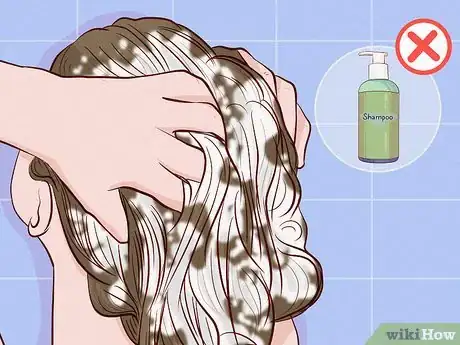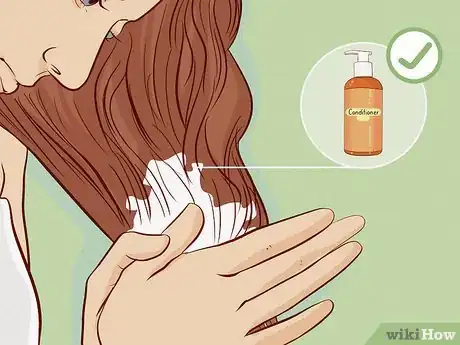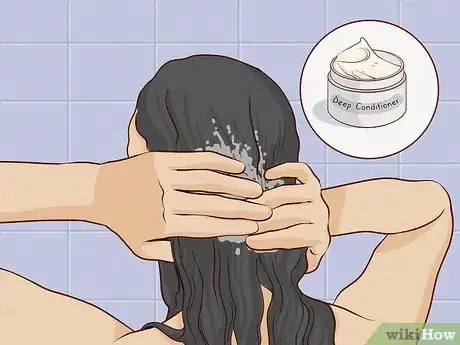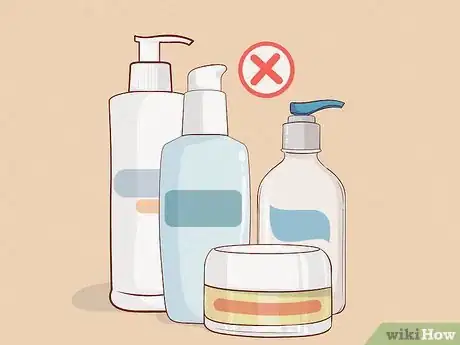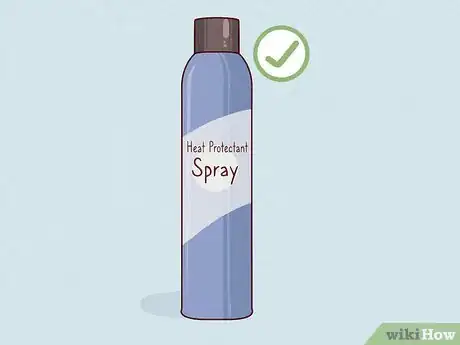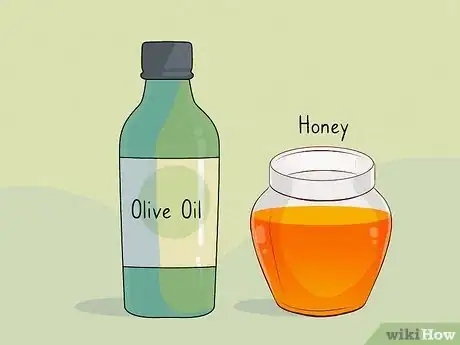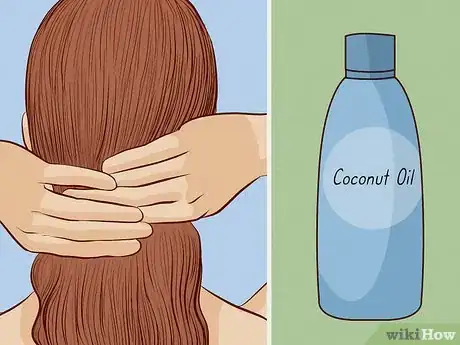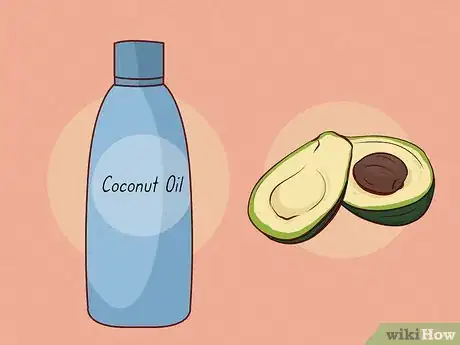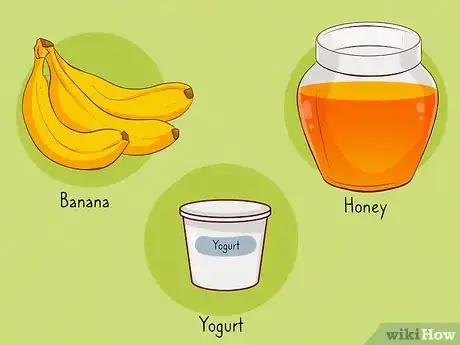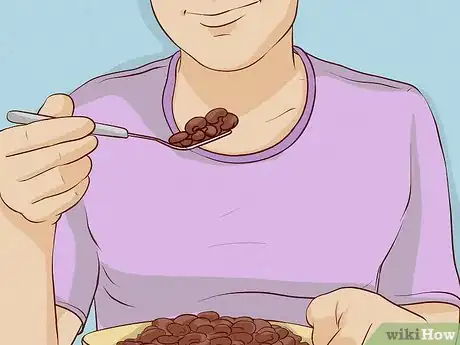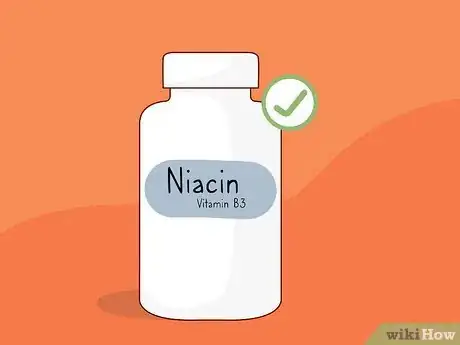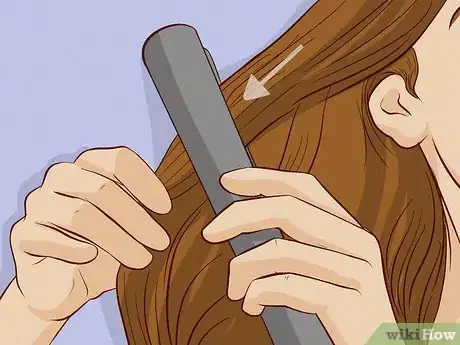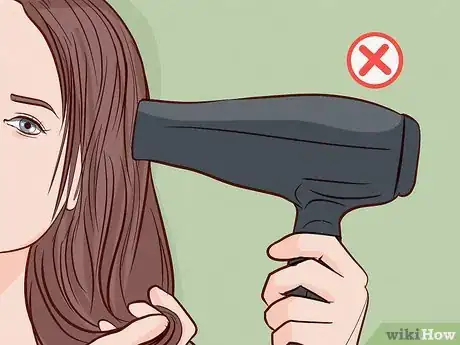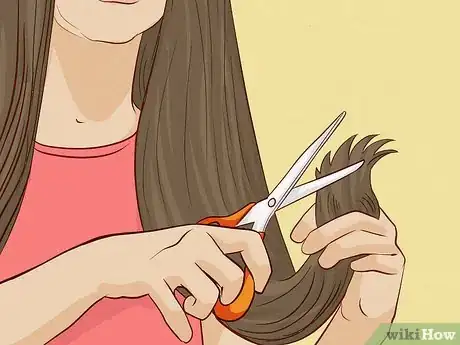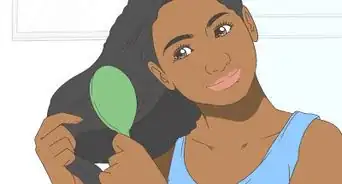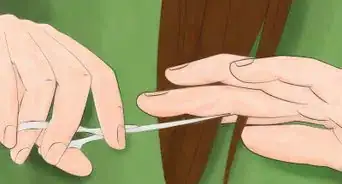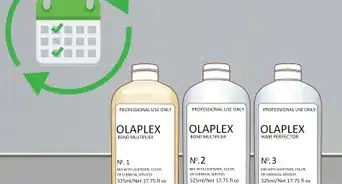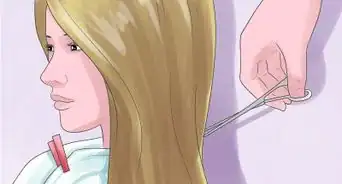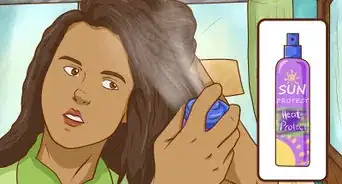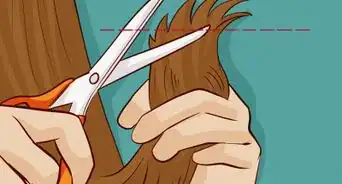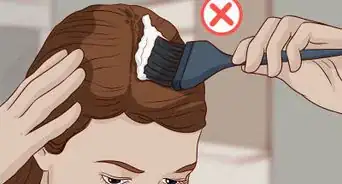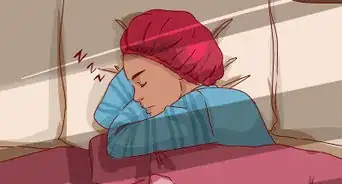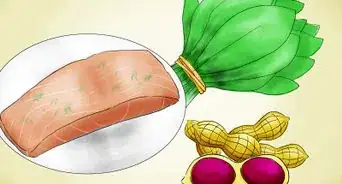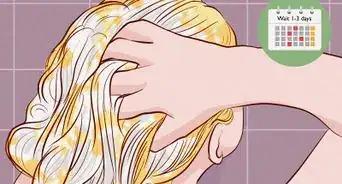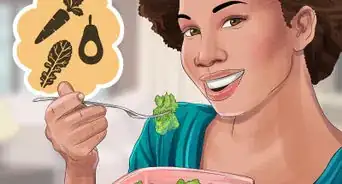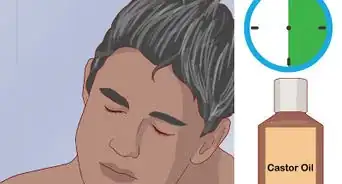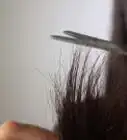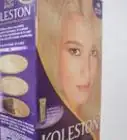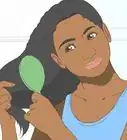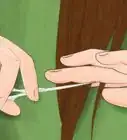This article was co-authored by Patrick Evan. Patrick Evan is the Owner of Patrick Evan Salon, a hair salon in San Francisco, California. He has been a hairstylist for over 25 years and is a Thermal Reconditioning Specialist, dedicated to transforming difficult curls and waves into sleek, straight hair. Patrick Evan Salon was rated the Best Hair Salon in San Francisco by Allure magazine, and Patrick's work has been featured in Woman’s Day, The Examiner, and 7x7.
This article has been viewed 243,348 times.
Hair is never technically living. However, when treated correctly, hair can look shiny, bright, and vibrant. Things like overuse of products and hair dye can leave hair damaged. To repair damaged hair and restore a living look, you can use products like conditioners and conditioning masks. You can also try natural products that are good for hair. In the future, take steps to minimize further damage. Eat foods that promote hair health and refrain from using things like flat irons too often.
Steps
Using Products to Treat Damaged Hair
-
1Shampoo your hair less frequently. If your hair is dry and damaged, limit your use of shampoo. Shampoo can remove oils your hair needs to repair damage, so it's a good idea to cut back on how often you're shampooing your hair.
- For example, if you usually shampoo your hair every day, try shampooing it every other day or twice a week instead.
- If you've done something that has caused damage to your hair, such as coloring it, it's important to avoid shampoo for 48 hours afterward.
-
2Use a conditioner that's designed for your hair type. Applying a conditioner to your hair each day can help make it softer and healthier. You can even apply conditioner twice a day—once in the shower, and then once with a leave-in conditioner after you get out of the shower.
- If you have coarse hair, use a moisturizing conditioner.
- If your hair is dry and brittle, look for a conditioner designed to nourish dry hair.
Advertisement -
3Treat your hair with a deep conditioning mask once a week. A deep conditioning mask can help replenish dry or damaged hair. Once a week, set aside of a chunk of time to deep condition your hair. Keep doing so until your hair is replenished and healthy again. In the shower, apply a liberal amount of your chosen conditioning mask.
- How long you leave a mask in place depends on the product. Refer to instructions on your product to see precisely how long you should leave your mask in place.
-
4Avoid chemicals and hair dyes. When your hair is damaged, avoid chemical-heavy products. Opt for hair products will a shorter ingredients list that is made up of mostly natural ingredients. You should also avoid hair dye. If you need a dye touch up, wait to get it done until your hair has healed.[1]
- Avoid products that contain surfactants like sodium lauryl sulfate.
-
5Apply a heat protectant spray if you're going to use heat styling tools.[2] Heat protectant sprays can help protect your hair from the damage that heat styling tools cause. Just spray your hair with one before you style it so it doesn't get frizzy and damaged.
Trying Natural Methods
-
1Treat your hair with olive oil and honey. Olive oil and honey is one of the best natural treatment options for damaged hair. To use olive oil and honey, mix half a cup of olive oil with a quarter cup of honey. Work the mixture into your hair. Then, wash the mixture out with a gentle shampoo.
- Do not use too much shampoo to remove the mixture, as shampoo can dry out damaged hair.
-
2Add oils to your roots. Oils like olive, coconut, and almond oil can help replenish hair at the roots. If your hair is damaged, work your chosen oil into your scalp. Gently massage a small amount of oil into your roots and let it sit for two hours.[3]
- After two hours have passed, rinse the oil out.
-
3Try avocado and coconut oil. Mix one tablespoon of mashed avocado, two tablespoons of coconut oil, and a teaspoon of honey together. When you're done, work the mixture into your hair.
- You should wrap your hair in a towel after applying this mixture as it gets very messy.
- Leave the mask in place for 20 minutes before washing it out of your hair.
-
4Use banana, honey, and yogurt. Mash one banana and mix it together with a quarter cup of honey and half a cup of yogurt. Then, work the mixture into your hair. You will need to secure your hair in a towel, as this mixture can drip a lot.
- Leave the mixture in place for an hour and then wash out your hair.
Preventing Future Damage
-
1Eat healthy.[4] A healthy diet can make your hair less prone to damage. If your hair seems to dry out and become damaged easily, try altering your diet. Opt for a diet rich in fruits and vegetables as well as healthy protein sources like nuts.[5]
- Omega-3 fatty acids are good for hair, so go for foods like walnuts and salmon.[6]
- Vitamin B12, found in eggs and avocado, is also good for hair health.
-
2Talk to your doctor about supplements. If your hair gets damaged often, dietary supplements such as niacin, biotin, and Vitamin E can help.[7] However, you should never take supplements without consulting your doctor. You want to make sure they're safe for you given your current health and will not interfere with any existing medication.[8]
-
3Limit your use of flat irons and curling irons.[9] Heat styling tools can damage hair from overuse, so do not flat iron or curl your hair too often. Save the flat iron and curling iron for special occasions, such as a night out, rather than using them as a part of your daily hair care routine.
-
4Do not blow dry your hair completely. Allow your hair to at least partially air dry. Overuse of blow dryers can cause hair to dry out and become damaged. Give your hair a light blow drying to add a little volume. Then, let your hair air dry the rest of the way.
-
5Cut off split ends. Split ends cannot be repaired. If you notice your hair has split ends, take care of them right away. Make an appointment with a hair stylist to cut off your split ends. This will stop them from causing further damage to your hair.
- Make it a goal to get your hair trimmed every 6–8 weeks so it stays healthy.
Expert Q&A
Did you know you can get expert answers for this article?
Unlock expert answers by supporting wikiHow
-
QuestionHow can I safely use heat styling tools?
 Patrick EvanPatrick Evan is the Owner of Patrick Evan Salon, a hair salon in San Francisco, California. He has been a hairstylist for over 25 years and is a Thermal Reconditioning Specialist, dedicated to transforming difficult curls and waves into sleek, straight hair. Patrick Evan Salon was rated the Best Hair Salon in San Francisco by Allure magazine, and Patrick's work has been featured in Woman’s Day, The Examiner, and 7x7.
Patrick EvanPatrick Evan is the Owner of Patrick Evan Salon, a hair salon in San Francisco, California. He has been a hairstylist for over 25 years and is a Thermal Reconditioning Specialist, dedicated to transforming difficult curls and waves into sleek, straight hair. Patrick Evan Salon was rated the Best Hair Salon in San Francisco by Allure magazine, and Patrick's work has been featured in Woman’s Day, The Examiner, and 7x7.
Professional Hair Stylist
-
QuestionDoes your diet matter in keeping your hair healthy?
 Patrick EvanPatrick Evan is the Owner of Patrick Evan Salon, a hair salon in San Francisco, California. He has been a hairstylist for over 25 years and is a Thermal Reconditioning Specialist, dedicated to transforming difficult curls and waves into sleek, straight hair. Patrick Evan Salon was rated the Best Hair Salon in San Francisco by Allure magazine, and Patrick's work has been featured in Woman’s Day, The Examiner, and 7x7.
Patrick EvanPatrick Evan is the Owner of Patrick Evan Salon, a hair salon in San Francisco, California. He has been a hairstylist for over 25 years and is a Thermal Reconditioning Specialist, dedicated to transforming difficult curls and waves into sleek, straight hair. Patrick Evan Salon was rated the Best Hair Salon in San Francisco by Allure magazine, and Patrick's work has been featured in Woman’s Day, The Examiner, and 7x7.
Professional Hair Stylist
-
QuestionWhat happens if I don't tend to my split ends?
 Laura MartinLaura Martin is a Licensed Cosmetologist in Georgia. She has been a hair stylist since 2007 and a cosmetology teacher since 2013.
Laura MartinLaura Martin is a Licensed Cosmetologist in Georgia. She has been a hair stylist since 2007 and a cosmetology teacher since 2013.
Licensed Cosmetologist
References
- ↑ http://www.matrix.com/blog/9-ways-to-repair-treat-and-fix-damaged-hair
- ↑ Patrick Evan. Professional Hair Stylist. Expert Interview. 17 January 2019.
- ↑ http://makeupandbeauty.com/revive-damaged-hair-follicles-home-remedies/
- ↑ Patrick Evan. Professional Hair Stylist. Expert Interview. 17 January 2019.
- ↑ http://makeupandbeauty.com/revive-damaged-hair-follicles-home-remedies/
- ↑ http://www.redbookmag.com/beauty/hair/advice/g2030/remedies-for-dry-hair/?slide=10
- ↑ Patrick Evan. Professional Hair Stylist. Expert Interview. 17 January 2019.
- ↑ http://makeupandbeauty.com/revive-damaged-hair-follicles-home-remedies/
- ↑ Patrick Evan. Professional Hair Stylist. Expert Interview. 17 January 2019.
About This Article
To revive dull, dry hair, cut back to only washing your hair about twice a week. However, you should apply a conditioner to your hair each day, whether it’s a leave-in conditioner or one that you rinse out in the shower. Once a week, treat your hair with a deep conditioning mask to nourish it and add shine. You can either buy a mask or make one yourself out of olive oil and honey. In addition to conditioning your hair, avoid harsh chemicals and hair dyes, and apply a heat protectant before you heat style your hair. For tips from our cosmetology reviewer on how your diet can affect the health of your hair, keep reading!
